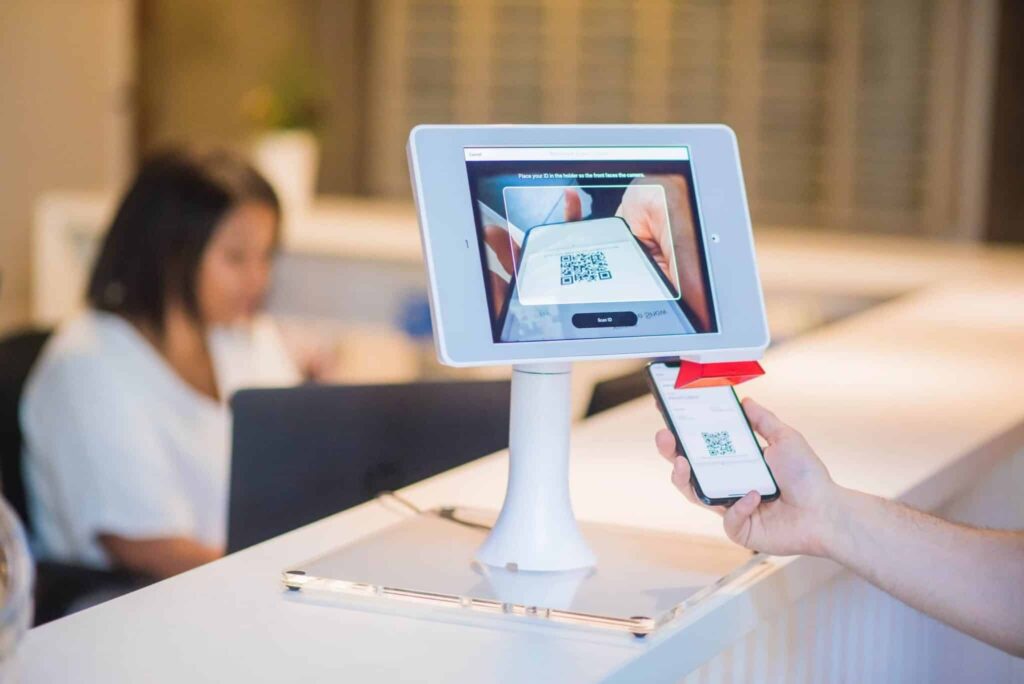Comparing Workplace Analytics Tools

The future of work is changing, and modern workplaces must change with it to remain productive and efficient. Hybrid work models, dynamic schedules, and new technologies have reinvented how businesses use their physical workspaces, and making the most of your real estate requires a new strategy and approach to workplace intelligence in the office. The trick to getting there? Analytics tools built for the future of hybrid work.
Effective decision-making about your office space starts with data. To maintain efficiency, optimize resources, and enhance the overall employee experience, you first need to know how your employees are using your workspaces and how that information can be used to improve them. This is known as workplace analytics.
As facilities managers, HR professionals, and other decision-making stakeholders increasingly rely on workplace analytics to guide their strategies, the demand for sophisticated tools that can collect, analyze, and apply meaningful insights is on the rise. In this article, we’ll explore the capabilities of various analytics software solutions designed for workplace analytics, examining the key criteria that organizations should consider when evaluating these tools and selecting one that will meet the unique needs and goals of your organization.

What is Workplace Analytics?
Workplace analytics involves using a variety of tools to collect data and gain insights into various aspects of the work environment, employee behavior, and organizational dynamics. It utilizes a broad range of data sources to understand how people work, collaborate, and utilize their physical or digital workspace so business leaders can gain actionable insights about their use of space.
Workplace analytics often goes hand-in-hand with workforce analytics, which measures HR data such as employee performance, productivity, engagement, and other key metrics. But while workforce analytics platforms focus on people data from a human resources and talent management perspective, workplace analytics software is primarily concerned with using data analysis to improve physical spaces. Measuring employee behavior and key metrics with analytics tools can also be utilized to streamline and improve employee onboarding in hybrid work environments, as well as build systems that reduce employee turnover—something all FM and HR teams can get behind.
Workplace and people analytics can provide valuable information for optimizing work processes, improving productivity, enhancing employee experience, and making data-driven decisions about the layout, design, and utilization of physical and digital workspaces. By leveraging a variety of algorithms and data sources, organizations can make informed decisions about how to create a more efficient, engaging, and supportive work environment.
Types of Workplace Analytics
The specific data you collect, as well as the tools and methods used to measure and analyze it, may depend on what information and insights will provide the most benefit for your particular business and office space. Often, a combination of different data sets is necessary to achieve a complete understanding of how to best utilize your space. Here are some of the metrics involved, their benefits, and the workplace tools you can use to measure them.
Space Utilization
Workforce planning requires knowing your space. Analyzing how physical office spaces are utilized, including desk occupancy, meeting room usage, hot desking, hoteling, and common area usage, is essential to properly organize your office layouts and design spaces to better support collaboration and productivity. Physical sensors, occupancy tracking systems, or workplace management software can be used to monitor desk and meeting room occupancy. Utilization rates can be calculated based on the ratio of occupied time to available time.
Productivity Metrics
Measuring and analyzing key productivity indicators helps identify patterns and trends in individual and team performance. This can include time spent on tasks, project completion rates, and other relevant metrics. These metrics, such as time spent on tasks, project completion rates, and output volume, can be measured using project management tools, time-tracking software, and performance management systems.
Employee Engagement
Assessing employee engagement and workforce data through various channels, such as surveys, feedback tools, and social collaboration platforms, helps you understand employee performance, address issues, and create a more positive and inclusive work environment. Employee surveys, feedback tools, and sentiment analysis of communication channels allow you to better understand the level of employee satisfaction and engagement.
Visibility
Visibility reports are crucial for tracking workday occupancy and office use, particularly for those with hybrid teams, remote workers, or frequent visitors. These reports, often initiated through badge integration, enable tracking of in-office employee locations, enhanced by real-time visual floorplans with sensors. This visibility data allows you to adjust your space to better facilitate collaboration, adapt to flexible seating trends, and improve request management, assisting FM and IT teams in refining desk and room booking strategies.
Cost Optimization
Business decisions are hard to make without the correct data. Measuring workspace utilization, resource allocation, and operational efficiency can help you identify opportunities for cost savings related to your office space. In hybrid work environments, where space utilization may fluctuate greatly, documenting and analyzing how your workspaces are being used will allow you to optimize your office configuration, streamline scheduling, and reduce overhead being spent on underutilized areas.
Security and Compliance
Workforce analytics tools can be used as built-in security guards for robust organizations. Monitoring and ensuring compliance with security policies and regulations is critical to maintaining security and privacy, especially in hybrid work environments. This may involve sophisticated machine learning for analyzing access logs, employee badge data, information-sharing patterns, and potential security risks. Security incident reports, compliance audits, and reviewing access protocols can help provide clarity on how well your office protects its sensitive data and secures its physical spaces.
Continuous Improvement
By constantly measuring these crucial data sets and metrics and gaining in-depth insights into your workspaces, you can create a culture of continuous improvement. Organizations can use this information to refine policies, processes, and initiatives, ensuring that they stay aligned with the evolving needs of their business.
Workplace Analytics and Workplace Intelligence

Workplace analytics goes hand in hand with workplace intelligence. If you’re unfamiliar with the concept of workplace intelligence, it’s simple. Similar to business intelligence, which involves analyzing data sources to gain a deeper understanding of market trends, customer behaviors, and operational efficiencies, workplace intelligence means optimizing your physical workspaces to streamline productivity, reduce overhead, and improve employee experience. Workplace analytics provides the data analysis necessary to achieve these goals.
By measuring not only the facility layout itself but also its design and how the configuration accommodates your business’s preferred work model (in-person offices, hybrid workplaces, remote work, etc), you can make data-driven decisions about how to improve your office.
How to Choose the Right Workplace Analytics Tools for Your Business
Comparing software tools for collecting and applying workplace analytics requires the consideration of several factors to ensure that the chosen solution aligns with your organization’s specific needs and goals. Here are some criteria for evaluating workplace analytics tools:
Data Sources
Assess the types of data the software can collect. This includes physical space utilization data, digital interaction data, productivity metrics, employee engagement data, and more. The tool should also be able to integrate with existing systems, such as physical sensors, Wifi logins, human resource platforms, IoT technologies, communication platforms, project management tools, and other relevant sources of data.
Data Analysis and Reporting Dashboards
Evaluate the tool’s analytical capabilities. Can it aggregate complex data sets and provide predictive analytics and trend analysis? Look for features that provide actionable insights.
How is the data presented? Visualizations, including dashboards and customizable reports, allow you to interpret and utilize data to make decisions effectively.
Integration
When considering a workplace analytics tool, the ability to seamlessly integrate with existing systems, including IoT technology, physical sensors, employee badges, Wifi logins, and other office technologies is crucial. An effective analytics solution should connect with human resources platforms, communication platforms, and project management tools to provide a holistic view of workforce dynamics.
User-Friendliness
Data collection and analysis are only useful if the information can be understood and applied easily. Therefore, the analytics platform’s user interface, visualizations, and dashboards must be intuitive and user-friendly. The tool should facilitate easy navigation and data exploration for users with varying levels of technical expertise.
Customization and Flexibility
Determine the level of customization the workplace analytics tool offers. Every organization has unique challenges and needs, and your workplace analytics software should be able to tailor solutions to the specific requirements of your business. In addition, those needs and challenges may change as your business grows and scales, so it’s best to use software that can easily adapt to new challenges.
Pricing
Understanding pricing and the total cost of implementation is a crucial benchmark when selecting an analytics tool. Costs may include licensing fees, training costs, and other additional expenses. The insights provided should contribute to measurable improvements in productivity, employee engagement, organizational performance, and cost savings, making the price of the software worth the investment.
Security and Compliance
When collecting data regarding employee performance and activities, it is critical to employ rigid safety measures to protect that information. Assess potential tools’ security measures, encryption standards, and access controls to safeguard sensitive employee data.
Ethical Considerations
It’s important to be upfront and communicative with your team members regarding data collection and tracking. Ensure that your workplace analytics software respects employee privacy, complies with ethical data usage practices, and provides transparency in how data is collected and used. Explain the purpose of data collection, and highlight how improvements based on these insights will increase employee satisfaction, engagement, and retention.
Why OfficeSpace Software is the Best Choice for Your Workplace
There is a wide variety of workplace analytics tools and techniques and a lot of information to consider when selecting the right one for your business. For organizations seeking a robust and versatile cloud-based analytics tool, OfficeSpace is an all-in-one solution that can help you continuously improve your workplace intelligence and workforce management, even as your company grows and workflows change.
When it comes to real-time data collection, sophisticated data analysis, seamless integrations, user-friendly templates, data visualizations, and dashboards, OfficeSpace has you covered. With this dynamic software, organizations can seamlessly integrate data from numerous sources, gaining deep insights into space utilization, employee productivity, HR analytics, and collaboration dynamics.
OfficeSpace’s ability to provide customized solutions and scalability allows it to adapt to your organization’s specific needs and use cases, supplying you with the insights you need to make data-driven decisions with confidence.
You can book a demo with OfficeSpace software today and start streamlining productivity, lowering costs, and improving your workplace experience with Workplace Intelligence today.




